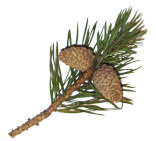first printed in Standfast 2017
The battle of Bannockburn followed soon after the contention between the Bruces and the Comyns for the Scottish crown had been 'resolved' when Robert the Bruce murdered John "The Red" Comyn in Dumfries. Bannockburn was followed by the "herschip" of the Comyns. "Herschip" is usually translated as "harrying", but the word is actually Old Norse and means "war ship" (ie longboat) - referring by analogy to the state the land was left in following a Viking raid for plunder, rape and pillage. Essentially Bruce dipossessed the Comyns of the overlordship of the great bulk of their lands which were handed out to Bruce supporters. But several Comyn families remained in place with new bosses.
As the Comyns had risen to prominence the Grants had attached themselves to them. [Actually they were (distantly) related because the Comyns descended untimately from Donalbane and his wife Hextilda (the daughter of Olaf Hemingsson) through their daughter Bethoc.] This closeness can be adjudged by the fact that John Grant, 4th Chief, married Bigla (Matilda) Comyn (about 1260). But by 1314, with Andrew Stewart very much on the scene (not yet chief, but acting on some occasions for his father-in-law (Sir John Grant)) allegiance had moved to Bruce and his supporters.
So in 1316 the Grants benefitted from the herschip with the award of "half of Inverallan". While the Comyns may have resented this, it was happening all over and the Grants were by no means the main beneficiaries - so all was reasonably amicable for nearly 100 years.
The feud started in 1410. Gilbert of Glencarnie (I am confident that our old Seannachies were right that he was a Comyn, but we cannot be absolutely certain) had only a daughter, also called Bigla/Matilda. The Comyns were determined that she should marry one of their own to keep the land (broadly what is now the parish of Duthil) in the family. But Bigla had a mind of her own and her choice was Sir John (Ian Roy) Grant. As soon as the marriage took place the Comyns took matters into their own hands. The Grant chief (Sir Patrick) was murdered on a visit to the Baron of Kincardine. Such was the immediate hostility from the neighbourhood (presumably Sir Patrick's entourage and his host's houshold) that the Comyn band were unable to make their escape and felt the need to take refuge in the kirk there. However a Grant shot a fire arrow into the roof of the church which then burned down killing all involved save one who ran away only to be decapitated by a stroke with a two handed sword. [I am reliably informed that this man's skull remains in the hands of the Earls of Seafield.]
The feud continued so that in 142o Ian Roy (chief since his father's murder) felt the necessity to dispose of the residual interest he had in Stratherrick to focus his clan more tightly around him, based at what is now Castle Grant. This was done, but the feud continued to simmer. In 1434 Ian Roy then thought up a stratagem which he hoped would end the feud. His mother was Finvola ("Florence") daughter of the Lachlan Lubanach Maclean 1st of Duart (hence a sister of Hector Roy nan Cath who was killed at Harlaw in 1411). Ian Roy appealed to his cousin, the swashbuckling Lachlan Bronnach, for help. The cunning plan was that Lachlan would "lift" some Comyn cattle; Ian Roy would ride to the rescue and restore the cattle to the Comyns who would, hopefully, be so grateful that they would cease their feuding.
The plan all went horribly wrong, for during the foray one of Lachlan's men accidentally shot and killed Ian Roy, who was buried under a cairn where he fell (Carn Ian Roy can still be found just north of the Sloch road about 4.5 miles ENE of Tomatin). Lachlan immediately hanged the man who had fired the errant shot our text avers that a tradition was established that whenever a chief of either clan died, the remaining chief would give the new chief a sword.
[I tried to look into this reported tradition. Sir Lachlan Maclean of Duart kindly referred me to an exchange of swords between Maclean of Duart and Irvine of Drum. This tradition was established immediately following the battle of Harlaw in 1411 where Hector Roy, the Maclean chief and Sir Alexander Irivine of Drum fought in single combat - a duel which resulted in the death of both men. Thus we may be sure that Lachlan Bronnach of our story did indeed instigate an exchange of swords. In this case it was to occur whenever the two chiefs met. While it is possible that our story really only features a borrowing of that one, the Monymusk Text implies the wrong Maclean, while this research shows that we have the right man and he has the form. Furthermore the circumstances are sufficiently different that we should suppose that there is truth in our lore, even if the tradition may not have lasted very long (though the way in which the story is related in ther Monymusk Text suggests that it was still current in the early 1600s when the original was authored). So it is sad that there is no corroborative evidence to be had; it is unfortunate that Maclean history has so little to relate about Lachlan Bronnach. But to be fair our own annals are not replete with detail about Sir John Roy and have even less to say about his father Sir Patrick.]
Sir Duncan Grant, the heir both of Ian Roy and of Gilbert of Glencarnie became the new chief of Grant and the Comyns ire was at last assuaged - albeit at far too heavy a price.
